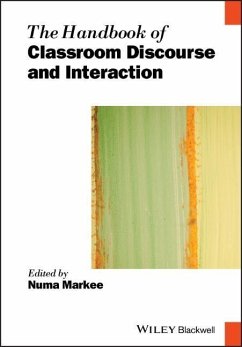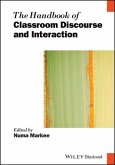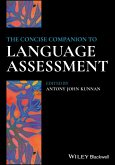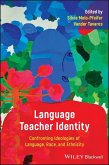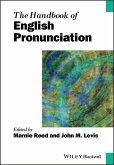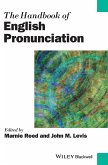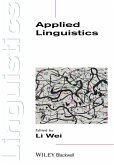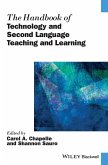Numa Markee
The Handbook of Classroom Discourse and Interaction
Numa Markee
The Handbook of Classroom Discourse and Interaction
- Broschiertes Buch
- Merkliste
- Auf die Merkliste
- Bewerten Bewerten
- Teilen
- Produkt teilen
- Produkterinnerung
- Produkterinnerung
Offering an interdisciplinary approach, The Handbook of Classroom Discourse and Interaction presents a series of contributions written by educators and applied linguists that explores the latest research methodologies and theories related to classroom language.
_ Organized to facilitate a critical understanding of how and why various research traditions differ and how they overlap theoretically and methodologically
_ Discusses key issues in the future development of research in critical areas of education and applied linguistics
_ Provides empirically-based analysis of classroom talk…mehr
Andere Kunden interessierten sich auch für
![The Handbook of Classroom Discourse and Interaction The Handbook of Classroom Discourse and Interaction]() Numa MarkeeThe Handbook of Classroom Discourse and Interaction238,99 €
Numa MarkeeThe Handbook of Classroom Discourse and Interaction238,99 €![The Concise Companion to Language Assessment The Concise Companion to Language Assessment]() The Concise Companion to Language Assessment42,99 €
The Concise Companion to Language Assessment42,99 €![Language Teacher Identity Language Teacher Identity]() Language Teacher Identity43,99 €
Language Teacher Identity43,99 €![The Handbook of English Pronunciation The Handbook of English Pronunciation]() Marnie ReedThe Handbook of English Pronunciation69,99 €
Marnie ReedThe Handbook of English Pronunciation69,99 €![The Handbook of English Pronunciation The Handbook of English Pronunciation]() Marnie ReedThe Handbook of English Pronunciation234,99 €
Marnie ReedThe Handbook of English Pronunciation234,99 €![Applied Linguistics Applied Linguistics]() Applied Linguistics38,99 €
Applied Linguistics38,99 €![The Handbook of Technology and Second Language Teaching and Learning The Handbook of Technology and Second Language Teaching and Learning]() The Handbook of Technology and Second Language Teaching and Learning239,99 €
The Handbook of Technology and Second Language Teaching and Learning239,99 €-
-
-
Offering an interdisciplinary approach, The Handbook of Classroom Discourse and Interaction presents a series of contributions written by educators and applied linguists that explores the latest research methodologies and theories related to classroom language.
_ Organized to facilitate a critical understanding of how and why various research traditions differ and how they overlap theoretically and methodologically
_ Discusses key issues in the future development of research in critical areas of education and applied linguistics
_ Provides empirically-based analysis of classroom talk to illustrate theoretical claims and methodologies
_ Includes multimodal transcripts, an emerging trend in education and applied linguistics, particularly in conversation analysis and sociocultural theory
Hinweis: Dieser Artikel kann nur an eine deutsche Lieferadresse ausgeliefert werden.
_ Organized to facilitate a critical understanding of how and why various research traditions differ and how they overlap theoretically and methodologically
_ Discusses key issues in the future development of research in critical areas of education and applied linguistics
_ Provides empirically-based analysis of classroom talk to illustrate theoretical claims and methodologies
_ Includes multimodal transcripts, an emerging trend in education and applied linguistics, particularly in conversation analysis and sociocultural theory
Hinweis: Dieser Artikel kann nur an eine deutsche Lieferadresse ausgeliefert werden.
Produktdetails
- Produktdetails
- Blackwell Handbooks in Linguistics 1
- Verlag: Wiley & Sons / Wiley-Blackwell
- Artikelnr. des Verlages: 1A119039900
- 1. Auflage
- Seitenzahl: 560
- Erscheinungstermin: 30. Januar 2019
- Englisch
- Abmessung: 241mm x 170mm x 33mm
- Gewicht: 833g
- ISBN-13: 9781119039907
- ISBN-10: 1119039908
- Artikelnr.: 50109773
- Herstellerkennzeichnung
- Libri GmbH
- Europaallee 1
- 36244 Bad Hersfeld
- gpsr@libri.de
- Blackwell Handbooks in Linguistics 1
- Verlag: Wiley & Sons / Wiley-Blackwell
- Artikelnr. des Verlages: 1A119039900
- 1. Auflage
- Seitenzahl: 560
- Erscheinungstermin: 30. Januar 2019
- Englisch
- Abmessung: 241mm x 170mm x 33mm
- Gewicht: 833g
- ISBN-13: 9781119039907
- ISBN-10: 1119039908
- Artikelnr.: 50109773
- Herstellerkennzeichnung
- Libri GmbH
- Europaallee 1
- 36244 Bad Hersfeld
- gpsr@libri.de
Numa Markee is Associate Professor in the Department of Linguistics at the University of Illinois at Urbana-Champaign, USA. He is an English Language Specialist for the US Department of State and author of Managing Curricular Innovation (1997) and Conversation Analysis (2000).
Notes on Contributors x
Acknowledgements xvi
Part I Preliminary Matters 1
1 Introduction: Classroom Discourse and Interaction Research 3
Numa Markee
Part II Research Methodologies and Assessment 21
Overview of the Research Methodologies and Assessment Section 23
Numa Markee
2 Developing a Multi-faceted Research Process: An Ethnographic Perspective for Reading Across Traditions 26
Judith L. Green, Maria Lúcia Castanheira, Audra Skukauskaite, and John W. Hammond
3 Understanding Classroom Discourse and Interaction: Qualitative Perspectives 44
Audra Skukauskaite, Jessica Rangel, Lisa Garcia Rodriguez, and Denise Krohn Ramón
4 Experimental Perspectives on Classroom Interaction 60
Mike Long
5 Shifting Trends in the Assessment of Classroom Interaction 74
Marta Antón
Part III The Educational Tradition 91
Overview of the Educational Tradition 93
Numa Markee
6 Discourse and Learning in Contexts of Educational Interaction 96
Carl H. Frederiksen and Janet Donin
7 Can Neo-Marxian and Poststructural Theories in Education Inform Each Other? Using Genre Approaches to Bridge the Gap 115
Ross Collin and Michael W. Apple
8 The Role of Talk in Group-based Activity in Classrooms 128
David Bloome
9 The Sequential Analysis of Instruction 142
Oskar Lindwall, Gustav Lymer, and Christian Greiffenhagen
Part IV The Cognitive Interactionist Tradition 159
Overview of the Cognitive Interactionist Tradition 161
Numa Markee
10 The Role of Tasks as Vehicles for Language Learning in Classroom Interaction 163
YouJin Kim
11 Comprehensible Input and Output in Classroom Interaction 182
Susan M. Gass
12 An Interactionist Approach to Learner-learner Interaction in Second and Foreign Language Classrooms 198
Melissa A. Bowles and Rebecca J. Adams
13 The Relative Effectiveness of Corrective Feedback in Classroom Interaction 213
Roy Lyster
Part V The Sociocultural Theory Tradition 229
Overview of the Sociocultural Theory Tradition 231
Numa Markee
14 From Interaction to Intra-action: The Internalization of Talk, Gesture, and Concepts in the Second Language Classroom 233
Eduardo Negueruela-Azarola, Próspero N. García, and Kimberly Buescher
15 Classroom Discourse and Interaction in the Zone of Proximal Development 250
Holbrook Mahn
16 The Emergence of Sociolinguistic Competence in L2 Classroom Interaction 265
Rémi A. van Compernolle
17 Sociocultural Approaches to Expert-novice Relationships in SecondLanguage Interaction 281
Steven L. Thorne and John Hellermann
Part VI The Language Socialization Tradition 299
Overview of the Language Socialization Tradition 301
Numa Markee
18 Literacy, Creativity, and Continuity: A Language Socialization Perspective on Heritage Language Classroom Interaction 304
Agnes Weiyun He
19 Language Socialization Across Learning Spaces 319
Jin Sook Lee and Mary Bucholtz
20 Academic Language and Literacy Socialization for Second Language Students 337
Patricia A. Duff and Tim Anderson
21 A Language Socialization Perspective on Identity Work of ESL Youth in a Superdiverse High School Classroom 353
Steven Talmy
Part VII The Conversation Analysis Tradition 369
Overview of the Conversation Analysis Tradition 371
Numa Markee
22 L2 Classroom Interaction as a Complex Adaptive System 373
Paul Seedhouse
23 Conversation-for-Learning: Institutional Talk Beyond the Classroom 390
Gabriele Kasper and Younhee Kim
24 Documenting Change Across Time: Longitudinal and Cross-sectional CA Studies of Clas
Acknowledgements xvi
Part I Preliminary Matters 1
1 Introduction: Classroom Discourse and Interaction Research 3
Numa Markee
Part II Research Methodologies and Assessment 21
Overview of the Research Methodologies and Assessment Section 23
Numa Markee
2 Developing a Multi-faceted Research Process: An Ethnographic Perspective for Reading Across Traditions 26
Judith L. Green, Maria Lúcia Castanheira, Audra Skukauskaite, and John W. Hammond
3 Understanding Classroom Discourse and Interaction: Qualitative Perspectives 44
Audra Skukauskaite, Jessica Rangel, Lisa Garcia Rodriguez, and Denise Krohn Ramón
4 Experimental Perspectives on Classroom Interaction 60
Mike Long
5 Shifting Trends in the Assessment of Classroom Interaction 74
Marta Antón
Part III The Educational Tradition 91
Overview of the Educational Tradition 93
Numa Markee
6 Discourse and Learning in Contexts of Educational Interaction 96
Carl H. Frederiksen and Janet Donin
7 Can Neo-Marxian and Poststructural Theories in Education Inform Each Other? Using Genre Approaches to Bridge the Gap 115
Ross Collin and Michael W. Apple
8 The Role of Talk in Group-based Activity in Classrooms 128
David Bloome
9 The Sequential Analysis of Instruction 142
Oskar Lindwall, Gustav Lymer, and Christian Greiffenhagen
Part IV The Cognitive Interactionist Tradition 159
Overview of the Cognitive Interactionist Tradition 161
Numa Markee
10 The Role of Tasks as Vehicles for Language Learning in Classroom Interaction 163
YouJin Kim
11 Comprehensible Input and Output in Classroom Interaction 182
Susan M. Gass
12 An Interactionist Approach to Learner-learner Interaction in Second and Foreign Language Classrooms 198
Melissa A. Bowles and Rebecca J. Adams
13 The Relative Effectiveness of Corrective Feedback in Classroom Interaction 213
Roy Lyster
Part V The Sociocultural Theory Tradition 229
Overview of the Sociocultural Theory Tradition 231
Numa Markee
14 From Interaction to Intra-action: The Internalization of Talk, Gesture, and Concepts in the Second Language Classroom 233
Eduardo Negueruela-Azarola, Próspero N. García, and Kimberly Buescher
15 Classroom Discourse and Interaction in the Zone of Proximal Development 250
Holbrook Mahn
16 The Emergence of Sociolinguistic Competence in L2 Classroom Interaction 265
Rémi A. van Compernolle
17 Sociocultural Approaches to Expert-novice Relationships in SecondLanguage Interaction 281
Steven L. Thorne and John Hellermann
Part VI The Language Socialization Tradition 299
Overview of the Language Socialization Tradition 301
Numa Markee
18 Literacy, Creativity, and Continuity: A Language Socialization Perspective on Heritage Language Classroom Interaction 304
Agnes Weiyun He
19 Language Socialization Across Learning Spaces 319
Jin Sook Lee and Mary Bucholtz
20 Academic Language and Literacy Socialization for Second Language Students 337
Patricia A. Duff and Tim Anderson
21 A Language Socialization Perspective on Identity Work of ESL Youth in a Superdiverse High School Classroom 353
Steven Talmy
Part VII The Conversation Analysis Tradition 369
Overview of the Conversation Analysis Tradition 371
Numa Markee
22 L2 Classroom Interaction as a Complex Adaptive System 373
Paul Seedhouse
23 Conversation-for-Learning: Institutional Talk Beyond the Classroom 390
Gabriele Kasper and Younhee Kim
24 Documenting Change Across Time: Longitudinal and Cross-sectional CA Studies of Clas
Notes on Contributors x Acknowledgements xvi Part I Preliminary Matters 1 1 Introduction: Classroom Discourse and Interaction Research 3 Numa Markee Part II Research Methodologies and Assessment 21 Overview of the Research Methodologies and Assessment Section 23 Numa Markee 2 Developing a Multi
faceted Research Process: An Ethnographic Perspective for Reading Across Traditions 26 Judith L. Green, Maria Lúcia Castanheira, Audra Skukauskaite, and John W. Hammond 3 Understanding Classroom Discourse and Interaction: Qualitative Perspectives 44 Audra Skukauskaite, Jessica Rangel, Lisa Garcia Rodriguez, and Denise Krohn Ramón 4 Experimental Perspectives on Classroom Interaction 60 Mike Long 5 Shifting Trends in the Assessment of Classroom Interaction 74 Marta Antón Part III The Educational Tradition 91 Overview of the Educational Tradition 93 Numa Markee 6 Discourse and Learning in Contexts of Educational Interaction 96 Carl H. Frederiksen and Janet Donin 7 Can Neo
Marxian and Poststructural Theories in Education Inform Each Other? Using Genre Approaches to Bridge the Gap 115 Ross Collin and Michael W. Apple 8 The Role of Talk in Group
based Activity in Classrooms 128 David Bloome 9 The Sequential Analysis of Instruction 142 Oskar Lindwall, Gustav Lymer, and Christian Greiffenhagen Part IV The Cognitive Interactionist Tradition 159 Overview of the Cognitive Interactionist Tradition 161 Numa Markee 10 The Role of Tasks as Vehicles for Language Learning in Classroom Interaction 163 YouJin Kim 11 Comprehensible Input and Output in Classroom Interaction 182 Susan M. Gass 12 An Interactionist Approach to Learner-learner Interaction in Second and Foreign Language Classrooms 198 Melissa A. Bowles and Rebecca J. Adams 13 The Relative Effectiveness of Corrective Feedback in Classroom Interaction 213 Roy Lyster Part V The Sociocultural Theory Tradition 229 Overview of the Sociocultural Theory Tradition 231 Numa Markee 14 From Interaction to Inträaction: The Internalization of Talk, Gesture, and Concepts in the Second Language Classroom 233 Eduardo Negueruela
Azarola, Próspero N. García, and Kimberly Buescher 15 Classroom Discourse and Interaction in the Zone of Proximal Development 250 Holbrook Mahn 16 The Emergence of Sociolinguistic Competence in L2 Classroom Interaction 265 Rémi A. van Compernolle 17 Sociocultural Approaches to Expert-novice Relationships in SecondLanguage Interaction 281 Steven L. Thorne and John Hellermann Part VI The Language Socialization Tradition 299 Overview of the Language Socialization Tradition 301 Numa Markee 18 Literacy, Creativity, and Continuity: A Language Socialization Perspective on Heritage Language Classroom Interaction 304 Agnes Weiyun He 19 Language Socialization Across Learning Spaces 319 Jin Sook Lee and Mary Bucholtz 20 Academic Language and Literacy Socialization for Second Language Students 337 Patricia A. Duff and Tim Anderson 21 A Language Socialization Perspective on Identity Work of ESL Youth in a Superdiverse High School Classroom 353 Steven Talmy Part VII The Conversation Analysis Tradition 369 Overview of the Conversation Analysis Tradition 371 Numa Markee 22 L2 Classroom Interaction as a Complex Adaptive System 373 Paul Seedhouse 23 Conversation
for
Learning: Institutional Talk Beyond the Classroom 390 Gabriele Kasper and Younhee Kim 24 Documenting Change Across Time: Longitudinal and Cross
sectional CA Studies of Classroom Interaction 409 Simona Pekarek Doehler and Virginie Fasel Lauzon 25 CA
for
SLA Studies of Classroom Interaction: Quo Vadis? 425 Numa Markee and Silvia Kunitz Part VIII The Critical Theory Tradition 441 Overview of the Critical Theory Tradition 443 Numa Markee 26 Multilingual Classroom Discourse as a Window on Wider Social, Political and Ideological Processes: Critical Ethnographic Approaches 446 Marilyn Martin
Jones 27 Power, Resistance and Second Language Learning 461 Elizabeth R. Miller 28 Seeing 'Language and Development' Play out in Classroom Interaction 475 Roslyn Appleby 29 The Social Construction of Inequality in and through Interaction in Multilingual Classrooms 490 Luisa Martín Rojo Part IX Final Words 507 30 Where Does Research on Classroom Discourse and Interaction Go From Here? 509 Numa Markee Appendix Transcription Conventions in Conversation Analysis 527 Index 529
faceted Research Process: An Ethnographic Perspective for Reading Across Traditions 26 Judith L. Green, Maria Lúcia Castanheira, Audra Skukauskaite, and John W. Hammond 3 Understanding Classroom Discourse and Interaction: Qualitative Perspectives 44 Audra Skukauskaite, Jessica Rangel, Lisa Garcia Rodriguez, and Denise Krohn Ramón 4 Experimental Perspectives on Classroom Interaction 60 Mike Long 5 Shifting Trends in the Assessment of Classroom Interaction 74 Marta Antón Part III The Educational Tradition 91 Overview of the Educational Tradition 93 Numa Markee 6 Discourse and Learning in Contexts of Educational Interaction 96 Carl H. Frederiksen and Janet Donin 7 Can Neo
Marxian and Poststructural Theories in Education Inform Each Other? Using Genre Approaches to Bridge the Gap 115 Ross Collin and Michael W. Apple 8 The Role of Talk in Group
based Activity in Classrooms 128 David Bloome 9 The Sequential Analysis of Instruction 142 Oskar Lindwall, Gustav Lymer, and Christian Greiffenhagen Part IV The Cognitive Interactionist Tradition 159 Overview of the Cognitive Interactionist Tradition 161 Numa Markee 10 The Role of Tasks as Vehicles for Language Learning in Classroom Interaction 163 YouJin Kim 11 Comprehensible Input and Output in Classroom Interaction 182 Susan M. Gass 12 An Interactionist Approach to Learner-learner Interaction in Second and Foreign Language Classrooms 198 Melissa A. Bowles and Rebecca J. Adams 13 The Relative Effectiveness of Corrective Feedback in Classroom Interaction 213 Roy Lyster Part V The Sociocultural Theory Tradition 229 Overview of the Sociocultural Theory Tradition 231 Numa Markee 14 From Interaction to Inträaction: The Internalization of Talk, Gesture, and Concepts in the Second Language Classroom 233 Eduardo Negueruela
Azarola, Próspero N. García, and Kimberly Buescher 15 Classroom Discourse and Interaction in the Zone of Proximal Development 250 Holbrook Mahn 16 The Emergence of Sociolinguistic Competence in L2 Classroom Interaction 265 Rémi A. van Compernolle 17 Sociocultural Approaches to Expert-novice Relationships in SecondLanguage Interaction 281 Steven L. Thorne and John Hellermann Part VI The Language Socialization Tradition 299 Overview of the Language Socialization Tradition 301 Numa Markee 18 Literacy, Creativity, and Continuity: A Language Socialization Perspective on Heritage Language Classroom Interaction 304 Agnes Weiyun He 19 Language Socialization Across Learning Spaces 319 Jin Sook Lee and Mary Bucholtz 20 Academic Language and Literacy Socialization for Second Language Students 337 Patricia A. Duff and Tim Anderson 21 A Language Socialization Perspective on Identity Work of ESL Youth in a Superdiverse High School Classroom 353 Steven Talmy Part VII The Conversation Analysis Tradition 369 Overview of the Conversation Analysis Tradition 371 Numa Markee 22 L2 Classroom Interaction as a Complex Adaptive System 373 Paul Seedhouse 23 Conversation
for
Learning: Institutional Talk Beyond the Classroom 390 Gabriele Kasper and Younhee Kim 24 Documenting Change Across Time: Longitudinal and Cross
sectional CA Studies of Classroom Interaction 409 Simona Pekarek Doehler and Virginie Fasel Lauzon 25 CA
for
SLA Studies of Classroom Interaction: Quo Vadis? 425 Numa Markee and Silvia Kunitz Part VIII The Critical Theory Tradition 441 Overview of the Critical Theory Tradition 443 Numa Markee 26 Multilingual Classroom Discourse as a Window on Wider Social, Political and Ideological Processes: Critical Ethnographic Approaches 446 Marilyn Martin
Jones 27 Power, Resistance and Second Language Learning 461 Elizabeth R. Miller 28 Seeing 'Language and Development' Play out in Classroom Interaction 475 Roslyn Appleby 29 The Social Construction of Inequality in and through Interaction in Multilingual Classrooms 490 Luisa Martín Rojo Part IX Final Words 507 30 Where Does Research on Classroom Discourse and Interaction Go From Here? 509 Numa Markee Appendix Transcription Conventions in Conversation Analysis 527 Index 529
Notes on Contributors x
Acknowledgements xvi
Part I Preliminary Matters 1
1 Introduction: Classroom Discourse and Interaction Research 3
Numa Markee
Part II Research Methodologies and Assessment 21
Overview of the Research Methodologies and Assessment Section 23
Numa Markee
2 Developing a Multi-faceted Research Process: An Ethnographic Perspective for Reading Across Traditions 26
Judith L. Green, Maria Lúcia Castanheira, Audra Skukauskaite, and John W. Hammond
3 Understanding Classroom Discourse and Interaction: Qualitative Perspectives 44
Audra Skukauskaite, Jessica Rangel, Lisa Garcia Rodriguez, and Denise Krohn Ramón
4 Experimental Perspectives on Classroom Interaction 60
Mike Long
5 Shifting Trends in the Assessment of Classroom Interaction 74
Marta Antón
Part III The Educational Tradition 91
Overview of the Educational Tradition 93
Numa Markee
6 Discourse and Learning in Contexts of Educational Interaction 96
Carl H. Frederiksen and Janet Donin
7 Can Neo-Marxian and Poststructural Theories in Education Inform Each Other? Using Genre Approaches to Bridge the Gap 115
Ross Collin and Michael W. Apple
8 The Role of Talk in Group-based Activity in Classrooms 128
David Bloome
9 The Sequential Analysis of Instruction 142
Oskar Lindwall, Gustav Lymer, and Christian Greiffenhagen
Part IV The Cognitive Interactionist Tradition 159
Overview of the Cognitive Interactionist Tradition 161
Numa Markee
10 The Role of Tasks as Vehicles for Language Learning in Classroom Interaction 163
YouJin Kim
11 Comprehensible Input and Output in Classroom Interaction 182
Susan M. Gass
12 An Interactionist Approach to Learner-learner Interaction in Second and Foreign Language Classrooms 198
Melissa A. Bowles and Rebecca J. Adams
13 The Relative Effectiveness of Corrective Feedback in Classroom Interaction 213
Roy Lyster
Part V The Sociocultural Theory Tradition 229
Overview of the Sociocultural Theory Tradition 231
Numa Markee
14 From Interaction to Intra-action: The Internalization of Talk, Gesture, and Concepts in the Second Language Classroom 233
Eduardo Negueruela-Azarola, Próspero N. García, and Kimberly Buescher
15 Classroom Discourse and Interaction in the Zone of Proximal Development 250
Holbrook Mahn
16 The Emergence of Sociolinguistic Competence in L2 Classroom Interaction 265
Rémi A. van Compernolle
17 Sociocultural Approaches to Expert-novice Relationships in SecondLanguage Interaction 281
Steven L. Thorne and John Hellermann
Part VI The Language Socialization Tradition 299
Overview of the Language Socialization Tradition 301
Numa Markee
18 Literacy, Creativity, and Continuity: A Language Socialization Perspective on Heritage Language Classroom Interaction 304
Agnes Weiyun He
19 Language Socialization Across Learning Spaces 319
Jin Sook Lee and Mary Bucholtz
20 Academic Language and Literacy Socialization for Second Language Students 337
Patricia A. Duff and Tim Anderson
21 A Language Socialization Perspective on Identity Work of ESL Youth in a Superdiverse High School Classroom 353
Steven Talmy
Part VII The Conversation Analysis Tradition 369
Overview of the Conversation Analysis Tradition 371
Numa Markee
22 L2 Classroom Interaction as a Complex Adaptive System 373
Paul Seedhouse
23 Conversation-for-Learning: Institutional Talk Beyond the Classroom 390
Gabriele Kasper and Younhee Kim
24 Documenting Change Across Time: Longitudinal and Cross-sectional CA Studies of Clas
Acknowledgements xvi
Part I Preliminary Matters 1
1 Introduction: Classroom Discourse and Interaction Research 3
Numa Markee
Part II Research Methodologies and Assessment 21
Overview of the Research Methodologies and Assessment Section 23
Numa Markee
2 Developing a Multi-faceted Research Process: An Ethnographic Perspective for Reading Across Traditions 26
Judith L. Green, Maria Lúcia Castanheira, Audra Skukauskaite, and John W. Hammond
3 Understanding Classroom Discourse and Interaction: Qualitative Perspectives 44
Audra Skukauskaite, Jessica Rangel, Lisa Garcia Rodriguez, and Denise Krohn Ramón
4 Experimental Perspectives on Classroom Interaction 60
Mike Long
5 Shifting Trends in the Assessment of Classroom Interaction 74
Marta Antón
Part III The Educational Tradition 91
Overview of the Educational Tradition 93
Numa Markee
6 Discourse and Learning in Contexts of Educational Interaction 96
Carl H. Frederiksen and Janet Donin
7 Can Neo-Marxian and Poststructural Theories in Education Inform Each Other? Using Genre Approaches to Bridge the Gap 115
Ross Collin and Michael W. Apple
8 The Role of Talk in Group-based Activity in Classrooms 128
David Bloome
9 The Sequential Analysis of Instruction 142
Oskar Lindwall, Gustav Lymer, and Christian Greiffenhagen
Part IV The Cognitive Interactionist Tradition 159
Overview of the Cognitive Interactionist Tradition 161
Numa Markee
10 The Role of Tasks as Vehicles for Language Learning in Classroom Interaction 163
YouJin Kim
11 Comprehensible Input and Output in Classroom Interaction 182
Susan M. Gass
12 An Interactionist Approach to Learner-learner Interaction in Second and Foreign Language Classrooms 198
Melissa A. Bowles and Rebecca J. Adams
13 The Relative Effectiveness of Corrective Feedback in Classroom Interaction 213
Roy Lyster
Part V The Sociocultural Theory Tradition 229
Overview of the Sociocultural Theory Tradition 231
Numa Markee
14 From Interaction to Intra-action: The Internalization of Talk, Gesture, and Concepts in the Second Language Classroom 233
Eduardo Negueruela-Azarola, Próspero N. García, and Kimberly Buescher
15 Classroom Discourse and Interaction in the Zone of Proximal Development 250
Holbrook Mahn
16 The Emergence of Sociolinguistic Competence in L2 Classroom Interaction 265
Rémi A. van Compernolle
17 Sociocultural Approaches to Expert-novice Relationships in SecondLanguage Interaction 281
Steven L. Thorne and John Hellermann
Part VI The Language Socialization Tradition 299
Overview of the Language Socialization Tradition 301
Numa Markee
18 Literacy, Creativity, and Continuity: A Language Socialization Perspective on Heritage Language Classroom Interaction 304
Agnes Weiyun He
19 Language Socialization Across Learning Spaces 319
Jin Sook Lee and Mary Bucholtz
20 Academic Language and Literacy Socialization for Second Language Students 337
Patricia A. Duff and Tim Anderson
21 A Language Socialization Perspective on Identity Work of ESL Youth in a Superdiverse High School Classroom 353
Steven Talmy
Part VII The Conversation Analysis Tradition 369
Overview of the Conversation Analysis Tradition 371
Numa Markee
22 L2 Classroom Interaction as a Complex Adaptive System 373
Paul Seedhouse
23 Conversation-for-Learning: Institutional Talk Beyond the Classroom 390
Gabriele Kasper and Younhee Kim
24 Documenting Change Across Time: Longitudinal and Cross-sectional CA Studies of Clas
Notes on Contributors x Acknowledgements xvi Part I Preliminary Matters 1 1 Introduction: Classroom Discourse and Interaction Research 3 Numa Markee Part II Research Methodologies and Assessment 21 Overview of the Research Methodologies and Assessment Section 23 Numa Markee 2 Developing a Multi
faceted Research Process: An Ethnographic Perspective for Reading Across Traditions 26 Judith L. Green, Maria Lúcia Castanheira, Audra Skukauskaite, and John W. Hammond 3 Understanding Classroom Discourse and Interaction: Qualitative Perspectives 44 Audra Skukauskaite, Jessica Rangel, Lisa Garcia Rodriguez, and Denise Krohn Ramón 4 Experimental Perspectives on Classroom Interaction 60 Mike Long 5 Shifting Trends in the Assessment of Classroom Interaction 74 Marta Antón Part III The Educational Tradition 91 Overview of the Educational Tradition 93 Numa Markee 6 Discourse and Learning in Contexts of Educational Interaction 96 Carl H. Frederiksen and Janet Donin 7 Can Neo
Marxian and Poststructural Theories in Education Inform Each Other? Using Genre Approaches to Bridge the Gap 115 Ross Collin and Michael W. Apple 8 The Role of Talk in Group
based Activity in Classrooms 128 David Bloome 9 The Sequential Analysis of Instruction 142 Oskar Lindwall, Gustav Lymer, and Christian Greiffenhagen Part IV The Cognitive Interactionist Tradition 159 Overview of the Cognitive Interactionist Tradition 161 Numa Markee 10 The Role of Tasks as Vehicles for Language Learning in Classroom Interaction 163 YouJin Kim 11 Comprehensible Input and Output in Classroom Interaction 182 Susan M. Gass 12 An Interactionist Approach to Learner-learner Interaction in Second and Foreign Language Classrooms 198 Melissa A. Bowles and Rebecca J. Adams 13 The Relative Effectiveness of Corrective Feedback in Classroom Interaction 213 Roy Lyster Part V The Sociocultural Theory Tradition 229 Overview of the Sociocultural Theory Tradition 231 Numa Markee 14 From Interaction to Inträaction: The Internalization of Talk, Gesture, and Concepts in the Second Language Classroom 233 Eduardo Negueruela
Azarola, Próspero N. García, and Kimberly Buescher 15 Classroom Discourse and Interaction in the Zone of Proximal Development 250 Holbrook Mahn 16 The Emergence of Sociolinguistic Competence in L2 Classroom Interaction 265 Rémi A. van Compernolle 17 Sociocultural Approaches to Expert-novice Relationships in SecondLanguage Interaction 281 Steven L. Thorne and John Hellermann Part VI The Language Socialization Tradition 299 Overview of the Language Socialization Tradition 301 Numa Markee 18 Literacy, Creativity, and Continuity: A Language Socialization Perspective on Heritage Language Classroom Interaction 304 Agnes Weiyun He 19 Language Socialization Across Learning Spaces 319 Jin Sook Lee and Mary Bucholtz 20 Academic Language and Literacy Socialization for Second Language Students 337 Patricia A. Duff and Tim Anderson 21 A Language Socialization Perspective on Identity Work of ESL Youth in a Superdiverse High School Classroom 353 Steven Talmy Part VII The Conversation Analysis Tradition 369 Overview of the Conversation Analysis Tradition 371 Numa Markee 22 L2 Classroom Interaction as a Complex Adaptive System 373 Paul Seedhouse 23 Conversation
for
Learning: Institutional Talk Beyond the Classroom 390 Gabriele Kasper and Younhee Kim 24 Documenting Change Across Time: Longitudinal and Cross
sectional CA Studies of Classroom Interaction 409 Simona Pekarek Doehler and Virginie Fasel Lauzon 25 CA
for
SLA Studies of Classroom Interaction: Quo Vadis? 425 Numa Markee and Silvia Kunitz Part VIII The Critical Theory Tradition 441 Overview of the Critical Theory Tradition 443 Numa Markee 26 Multilingual Classroom Discourse as a Window on Wider Social, Political and Ideological Processes: Critical Ethnographic Approaches 446 Marilyn Martin
Jones 27 Power, Resistance and Second Language Learning 461 Elizabeth R. Miller 28 Seeing 'Language and Development' Play out in Classroom Interaction 475 Roslyn Appleby 29 The Social Construction of Inequality in and through Interaction in Multilingual Classrooms 490 Luisa Martín Rojo Part IX Final Words 507 30 Where Does Research on Classroom Discourse and Interaction Go From Here? 509 Numa Markee Appendix Transcription Conventions in Conversation Analysis 527 Index 529
faceted Research Process: An Ethnographic Perspective for Reading Across Traditions 26 Judith L. Green, Maria Lúcia Castanheira, Audra Skukauskaite, and John W. Hammond 3 Understanding Classroom Discourse and Interaction: Qualitative Perspectives 44 Audra Skukauskaite, Jessica Rangel, Lisa Garcia Rodriguez, and Denise Krohn Ramón 4 Experimental Perspectives on Classroom Interaction 60 Mike Long 5 Shifting Trends in the Assessment of Classroom Interaction 74 Marta Antón Part III The Educational Tradition 91 Overview of the Educational Tradition 93 Numa Markee 6 Discourse and Learning in Contexts of Educational Interaction 96 Carl H. Frederiksen and Janet Donin 7 Can Neo
Marxian and Poststructural Theories in Education Inform Each Other? Using Genre Approaches to Bridge the Gap 115 Ross Collin and Michael W. Apple 8 The Role of Talk in Group
based Activity in Classrooms 128 David Bloome 9 The Sequential Analysis of Instruction 142 Oskar Lindwall, Gustav Lymer, and Christian Greiffenhagen Part IV The Cognitive Interactionist Tradition 159 Overview of the Cognitive Interactionist Tradition 161 Numa Markee 10 The Role of Tasks as Vehicles for Language Learning in Classroom Interaction 163 YouJin Kim 11 Comprehensible Input and Output in Classroom Interaction 182 Susan M. Gass 12 An Interactionist Approach to Learner-learner Interaction in Second and Foreign Language Classrooms 198 Melissa A. Bowles and Rebecca J. Adams 13 The Relative Effectiveness of Corrective Feedback in Classroom Interaction 213 Roy Lyster Part V The Sociocultural Theory Tradition 229 Overview of the Sociocultural Theory Tradition 231 Numa Markee 14 From Interaction to Inträaction: The Internalization of Talk, Gesture, and Concepts in the Second Language Classroom 233 Eduardo Negueruela
Azarola, Próspero N. García, and Kimberly Buescher 15 Classroom Discourse and Interaction in the Zone of Proximal Development 250 Holbrook Mahn 16 The Emergence of Sociolinguistic Competence in L2 Classroom Interaction 265 Rémi A. van Compernolle 17 Sociocultural Approaches to Expert-novice Relationships in SecondLanguage Interaction 281 Steven L. Thorne and John Hellermann Part VI The Language Socialization Tradition 299 Overview of the Language Socialization Tradition 301 Numa Markee 18 Literacy, Creativity, and Continuity: A Language Socialization Perspective on Heritage Language Classroom Interaction 304 Agnes Weiyun He 19 Language Socialization Across Learning Spaces 319 Jin Sook Lee and Mary Bucholtz 20 Academic Language and Literacy Socialization for Second Language Students 337 Patricia A. Duff and Tim Anderson 21 A Language Socialization Perspective on Identity Work of ESL Youth in a Superdiverse High School Classroom 353 Steven Talmy Part VII The Conversation Analysis Tradition 369 Overview of the Conversation Analysis Tradition 371 Numa Markee 22 L2 Classroom Interaction as a Complex Adaptive System 373 Paul Seedhouse 23 Conversation
for
Learning: Institutional Talk Beyond the Classroom 390 Gabriele Kasper and Younhee Kim 24 Documenting Change Across Time: Longitudinal and Cross
sectional CA Studies of Classroom Interaction 409 Simona Pekarek Doehler and Virginie Fasel Lauzon 25 CA
for
SLA Studies of Classroom Interaction: Quo Vadis? 425 Numa Markee and Silvia Kunitz Part VIII The Critical Theory Tradition 441 Overview of the Critical Theory Tradition 443 Numa Markee 26 Multilingual Classroom Discourse as a Window on Wider Social, Political and Ideological Processes: Critical Ethnographic Approaches 446 Marilyn Martin
Jones 27 Power, Resistance and Second Language Learning 461 Elizabeth R. Miller 28 Seeing 'Language and Development' Play out in Classroom Interaction 475 Roslyn Appleby 29 The Social Construction of Inequality in and through Interaction in Multilingual Classrooms 490 Luisa Martín Rojo Part IX Final Words 507 30 Where Does Research on Classroom Discourse and Interaction Go From Here? 509 Numa Markee Appendix Transcription Conventions in Conversation Analysis 527 Index 529
"This book, with contributions from leading researchers and rising stars, contains a plethora of essential information on classroom discourse and interaction, both thorough and practical. It is comprehensive, up to date, and extremely accessible. It will be essential reading for the current generation of applied linguists, and beyond."
Alison Mackey, Georgetown University, USA
Alison Mackey, Georgetown University, USA

